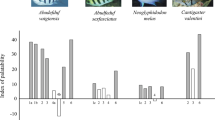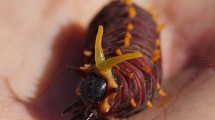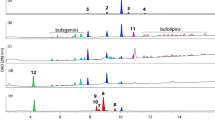Abstract
WHEN Acanthaster planci, the coral-predating crown-of-thorns starfish, encounters living coral or when it is presented with coral extracts, it rears the arms near to the stimulus source aborally and retracts the tube feet of these arms into the ambulacral groove1,2. This aversive behaviour has generally been attributed to the effect of discharge of coral nematocysts1–3, or to toxins released from nematocysts4. But arm rearing may be evoked before contact is made with corals, and both “withdrawal” responses are produced by non-coral food or food extracts which stimulate A. planci to feed (R.J.M., unpublished). This suggests that it is not nematocysts or their toxins which are responsible, but rather chemicals from coral tissue. The experiments described here show that this is the case: the function of the aversive response seems to be protection of the starfish against nematocyst discharge on contact with coral.
This is a preview of subscription content, access via your institution
Access options
Subscribe to this journal
Receive 51 print issues and online access
$199.00 per year
only $3.90 per issue
Buy this article
- Purchase on Springer Link
- Instant access to full article PDF
Prices may be subject to local taxes which are calculated during checkout
Similar content being viewed by others
References
Barnes, D. J., Brauer, R. W., and Jordan, M. R., Nature 228, 342–344 (1970).
Brauer, R. W., Jordan, M. R., and Barnes, D. J., Nature, 228, 344–346 (1970).
Ormond, R. F. G., and Campbell, A. C., in Proc. Second int. Coral Reef Symp., 1, 595–619 (Great Barrier Reef Committee, Brisbane, 1974).
Collins, A. R. S., J. exp. mar. Biol. Ecol. 17, 69–86 (1975).
Collins, A. R. S., J. exp. mar. Biol. Ecol. 15, 173–184 (1974).
Lowry, O. H., Rosenbrough, N. J., Farr, A. L., and Randall, R. J., J. biol. Chem., 193, 265 (1951).
Mackie, A. M., Mar. Biol., 21, 103–108 (1973).
Zafiriou, O., Mar. Biol., 17, 100–107 (1972).
Carr, W. E. S., Biol. Bull. mar. biol. Lab., Woods Hole, 133, 106–127 (1967).
Block, R. J., Durrum, E. L., and Sweig, G., A Manual of Paper Chromatography and Paper Electrophoresis (Academic, New York, 1958).
Valentincic, T., Netherlands J. Sea Res., 7, 191–199 (1973).
Fenchel, T., Ophelia, 2, 223–236 (1965).
Christensen, A. M., Ophelia, 8, 1–134 (1970).
Mauzey, K. P., Birkeland, C., and Dayton, P. K., Ecology, 49, No. 4, 603–619 (1968).
Author information
Authors and Affiliations
Rights and permissions
About this article
Cite this article
MOORE, R., HUXLEY, C. Aversive behaviour of crown-of-thorns starfish to coral evoked by food-related chemicals. Nature 263, 407–409 (1976). https://doi.org/10.1038/263407a0
Received:
Accepted:
Issue Date:
DOI: https://doi.org/10.1038/263407a0
This article is cited by
-
New insights into the ecology and corallivory of Culcita sp. (Echinodermata: Asteroidea) in the Republic of Maldives
Hydrobiologia (2019)
-
Chemical Ecology of Chemosensation in Asteroidea: Insights Towards Management Strategies of Pest Species
Journal of Chemical Ecology (2018)
-
Abundant betaines in reef-building corals and ecological indicators of a photoprotective role
Coral Reefs (2010)
-
Behavioral study of chemoreception in the sea starMarthasterias glacialis: Structure-activity relationships of lactic acid, amino acids, and acetylcholine
Journal of Comparative Physiology A (1985)
Comments
By submitting a comment you agree to abide by our Terms and Community Guidelines. If you find something abusive or that does not comply with our terms or guidelines please flag it as inappropriate.



